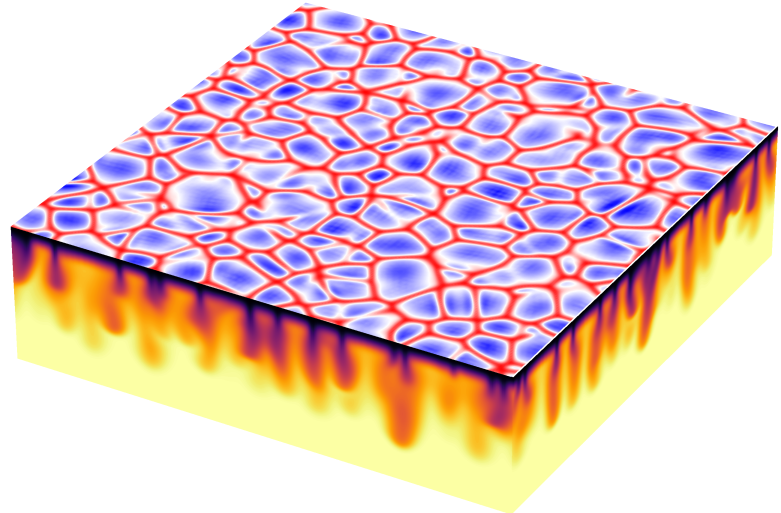Salt polygons and porous media convection
Graz University of Technology | Complexity Science Hub Vienna
Jana Lasser | jana.lasser@tugraz.at | @janalasser
Salt deserts are not dry!
What drives their formation?
Overview
Characteristic features of salt polygons in nature
A mechanism that explains salt polygons should ...
... occur in salt pan environments.
... be able to spatially modulate salt flux to the surface.
... generate closed polygons with a wavelength of 1-2 m.
... be robust to environmental variations.
... be stable for long enough to enable ridge growth.
Existing explanations for salt polygon formation
(and why we believe they don't work)
no closed polygons
... but they might be secondary mechanisms, occuring only after a different mechanism determined the scale and shape of the patterns first.
Porous media convection as a new mechanism
Idea: Connect surface pattern expression to dynamics in the underground.
Saline water saturates the porous soil. Water evaporates, a vertical salinity gradient builds up. Density-driven convection arises.
Saline water saturates the porous soil. Water evaporates, a vertical salinity gradient builds up. Density-driven convection arises.
Saline water saturates the porous soil. Water evaporates, a vertical salinity gradient builds up. Density-driven convection arises.
Saline water saturates the porous soil. Water evaporates, a vertical salinity gradient builds up. Density-driven convection arises.
Upwelling and downwelling plumes cause horizontal salinity gradients. Salt precipitates preferentially in regions of high salinity.
Upwelling and downwelling plumes cause horizontal salinity gradients. Salt precipitates preferentially in regions of high salinity.
Upwelling and downwelling plumes cause horizontal salinity gradients. Salt precipitates preferentially in regions of high salinity.
Some math ...
Some math ...
Some math ...
Some math ...
Some math ...
Nondimensionalization
Nondimensionalization is the removal of physical dimensions (e.g., units) from an equation involving physical quantities by a suitable substitution of variables. This technique can simplify and parameterize problems where measured units are involved.
To do this, we find "natural units" of the system. We then substitute variables with natural units to arrive at nondimensionalized equations.
A mechanism that explains salt polygons should ...
... occur in salt pan environments.
... be able to spatially modulate salt flux to the surface.
... generate closed polygons with a wavelength of 1-2 m.
... be robust to environmental variations.
... be stable for long enough to enable ridge growth.
A mechanism that explains salt polygons should ...
... occur in salt pan environments.
... be able to spatially modulate salt flux to the surface.
... generate closed polygons with a wavelength of 1-2 m.
... be robust to environmental variations.
... be stable for long enough to enable ridge growth.
Two-dimensional simulations of density-driven convection
Horizontal inhomogeneities in the salinity flux to the surface, tied to downwellings.
The simulation predicts increased salinity flux (ridge growth) above downwellings. Can we find the gradients in nature?
The simulation predicts horizontal salinity gradients below salt ridges. Can we find the gradients in nature?
The simulation predicts horizontal salinity gradients below salt ridges. Can we find the gradients in nature?
Salinity profiles from polygon cross-sections
There are horizontal salinity gradients in the field.
Locations of high salinity in the sediment are correlated with locations of ridges at the surface.
A mechanism that explains salt polygons should ...
... occur in salt pan environments.
... be able to spatially modulate salt flux to the surface.
... generate closed polygons with a wavelength of 1-2 m.
... be robust to environmental variations.
... be stable for long enough to enable ridge growth.
Let's systematically explore the distance between plumes (wavelength) for different Ra.
Why polygons?
Convection rolls minimize surface while maximizing volume.
Why polygons?
"Squeezing" them next to each other in 2D produces hexagons.
Full 3D simulation of dynamics reproduces polygons

A mechanism that explains salt polygons should ...
... occur in salt pan environments.
... be able to spatially modulate salt flux to the surface.
... generate closed polygons with a wavelength of 1-2 m.
... be robust to environmental variations.
... be stable for long enough to enable ridge growth.
Until now we have only considered the impact of dynamics in the underground acting on crust growth.
What if there is a feedback process and the crust also influences the dynamics in the underground?
Evaporation drives the system. Feedback could act on the evaporation rate E.
Modulation of the evaporation rate E at the top boundary
Temperature and humindity measurement in the field
Low temperature and high humidity both reduce the evaporation rate E.
Temperature and humindity measurement in the field
Low temperature and high humidity both reduce the evaporation rate E.
Temperature and humindity measurement in the field
Low temperature and high humidity (not shown) both reduce the evaporation rate E.
Summary: Porous media convection
... is a mechanism that occurs in salt pan environments.
Ra > Rac at all field sites
Summary: Porous media convection
... is able to spatially modulate salt flux to the surface.
Summary: Porous media convection
... generates closed polygons ...
Summary: Porous media convection
... with a wavelength of 1-2 m.
Summary: Porous media convection
... is stable for long enough to account for substantial ridge growth.
More details at:
- Lasser et al., "Salt Polygons and Porous Media Convection", PRX (2023), https://doi.org/10.1103/PhysRevX.13.011025
- Lasser et al., "Stability and dynamics of convection in dry salt lakes", J. Fluid Mech. (2021), https://arxiv.org/abs/2004.10578
- Lasser et al., "Surface and subsurface characterisation of salt pans expressing polygonal patterns", ESSD (2020), https://doi.org/10.5194/essd-12-2881-2020
Simulation code at: